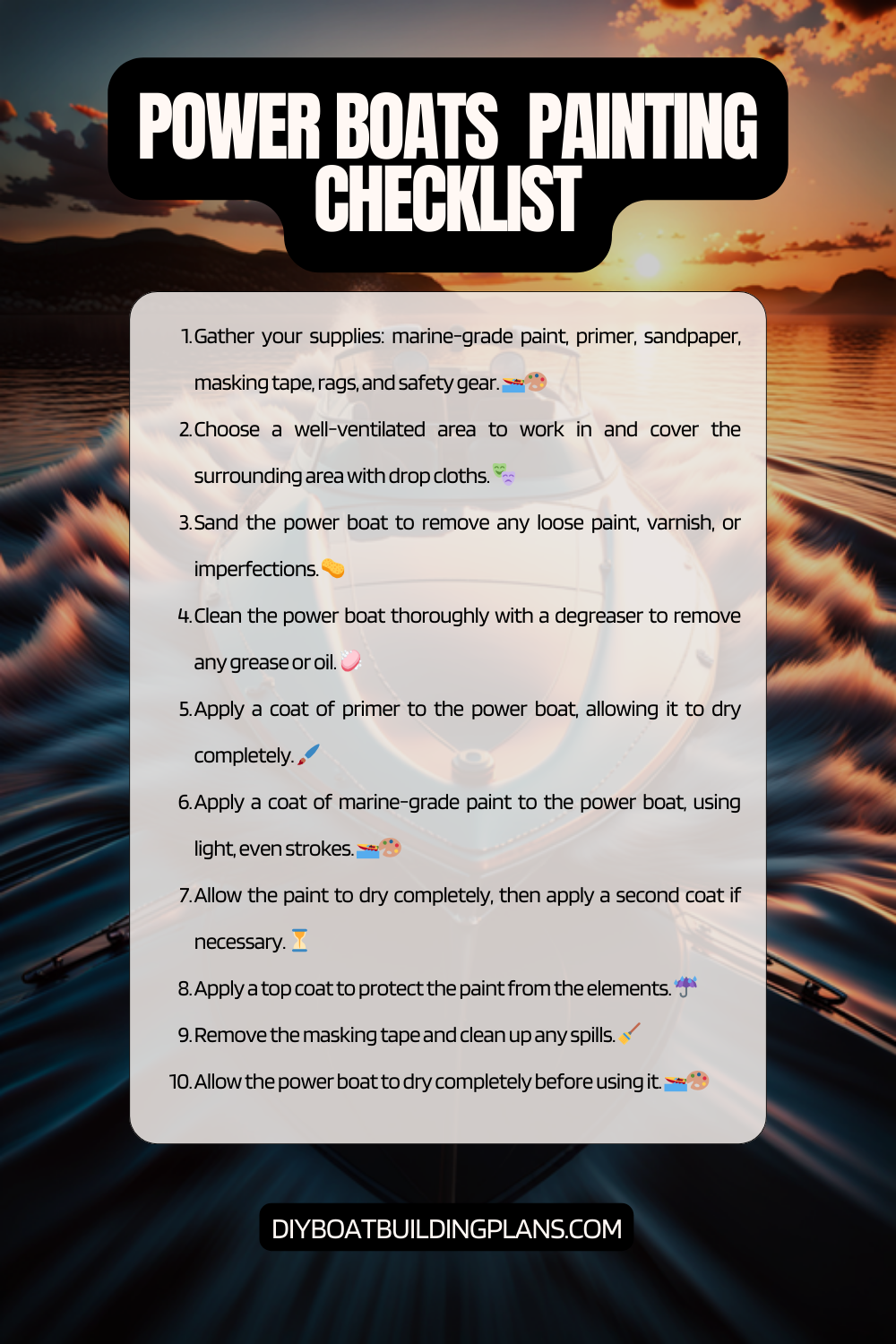Overview of Power Boat Painting Tips
Power boat painting is an essential aspect of boat maintenance that is often overlooked by boat owners. A well-painted power boat not only enhances its appearance but also provides protection against water damage and corrosion. Whether you are a seasoned boater or a novice, understanding the importance of proper power boat painting is crucial to ensure the longevity and value of your vessel.
Key Takeaways
- Proper power boat painting is important for both aesthetic and functional reasons.
- Choosing the right paint and properly preparing the boat are crucial steps in the process.
- Sanding and applying primer are important steps to ensure a smooth and long-lasting paint job.
- Common mistakes to avoid include rushing the process and not properly maintaining the paint job.
- Hiring a professional power boat painter can save time and ensure a high-quality result.

Importance of Proper Power Boat Painting
One of the primary reasons for investing in proper power boat painting is to protect your boat against water damage and corrosion. Power boats are constantly exposed to harsh marine environments, including saltwater, which can cause significant damage over time. A high-quality paint job acts as a barrier, preventing water from seeping into the boat’s structure and causing rot or corrosion.
In addition to protection, a well-painted power boat also enhances its appearance. A sleek and well-maintained boat not only turns heads but also gives you a sense of pride as a boat owner. Whether you use your power boat for personal enjoyment or for commercial purposes, a visually appealing vessel creates a positive impression and reflects your attention to detail.
Furthermore, proper power boat painting can significantly increase the resale value of your boat. Potential buyers are more likely to be attracted to a power boat that has been well-maintained and has a fresh coat of paint. A professionally painted power boat gives the impression that the vessel has been cared for and is in good condition, which can result in a higher selling price.
Choosing the Right Paint for Your Power Boat
When it comes to choosing paint for your power boat, there are several factors to consider. The type of paint you select will depend on various factors such as the material of your boat, the intended use of the vessel, and your personal preferences.
There are two main types of paint available for power boats: one-part paints and two-part paints. One-part paints are easier to apply and are suitable for boats that are used in freshwater or have limited exposure to harsh marine environments. Two-part paints, on the other hand, offer superior durability and protection, making them ideal for boats that are frequently exposed to saltwater or extreme weather conditions.
When choosing paint, it is essential to consider the brand’s reputation and quality. Some recommended brands for power boat painting include Interlux, Awlgrip, and Pettit. These brands have a proven track record of producing high-quality marine paints that offer excellent protection and longevity.
Preparing Your Power Boat for Painting
| Task | Time Required | Materials Needed | Cost |
| Cleaning the Boat | 2-3 hours | Soap, water, scrub brush, hose | 0 |
| Sanding the Boat | 4-6 hours | Sandpaper, sanding block, respirator mask | 50 |
| Masking the Boat | 1-2 hours | Masking tape, plastic sheeting | 20 |
| Priming the Boat | 2-3 hours | Primer, paint sprayer or brush/roller, respirator mask | 100 |
| Painting the Boat | 4-6 hours | Paint, paint sprayer or brush/roller, respirator mask | 150 |
| Drying Time | 24-48 hours | N/A | 0 |
Before you can start painting your power boat, proper preparation is crucial. This involves cleaning and degreasing the surface, removing old paint and rust, and filling in any cracks or holes.
To clean the surface of your power boat, use a marine-grade cleaner and a soft brush or sponge. This will remove any dirt, grime, or salt residue that may interfere with the adhesion of the paint. After cleaning, it is important to thoroughly rinse the boat with fresh water to remove any remaining cleaning solution.
If your power boat has existing paint that is peeling or flaking, it is necessary to remove it before applying a new coat. This can be done using a paint stripper or by sanding the surface. Additionally, any rust spots should be treated with a rust converter or removed using sandpaper or a wire brush.
Once the surface is clean and free of old paint and rust, it is important to fill in any cracks or holes using an appropriate marine-grade filler. This will ensure a smooth and even surface for painting.
Tips for Sanding Your Power Boat
Sanding is a crucial step in power boat painting as it helps create a smooth surface for the paint to adhere to. It is recommended to start with a coarse-grit sandpaper (around 80-120 grit) to remove any remaining paint or rough spots. As you progress, gradually switch to finer-grit sandpaper (around 220-320 grit) to achieve a smoother finish.
When sanding your power boat, it is important to pay attention to different areas that may require different techniques. For flat surfaces, use long, even strokes in the direction of the grain. For curved or contoured areas, it may be necessary to use sanding blocks or sponges to ensure an even finish.
Always remember to wear protective gear such as goggles and a dust mask when sanding to protect yourself from dust and debris. Additionally, be mindful of the amount of pressure applied during sanding to avoid damaging the boat’s surface.
Applying Primer to Your Power Boat
Applying primer is a crucial step in power boat painting as it provides adhesion and durability for the paint. Primer acts as a base coat that helps the paint adhere to the surface and provides an additional layer of protection against water damage and corrosion.
There are different types of primers available for power boats, including epoxy primers and etching primers. Epoxy primers are known for their excellent adhesion and durability, making them suitable for boats that are frequently exposed to harsh marine environments. Etching primers, on the other hand, are designed to provide adhesion on bare metal surfaces and are ideal for boats with aluminum hulls.
When applying primer to your power boat, it is important to follow the manufacturer’s instructions regarding mixing ratios and application techniques. Generally, primer should be applied in thin, even coats using a high-quality brush or roller. It is recommended to apply multiple coats of primer, allowing sufficient drying time between each coat.
Tips for Applying Paint to Your Power Boat
Once the primer has dried, it is time to apply the paint to your power boat. Proper application techniques are essential to achieve an even and professional-looking finish.
When applying paint, it is important to use long, even strokes in the direction of the grain or contours of the boat. This will help ensure an even distribution of paint and minimize the appearance of brush or roller marks. It is also recommended to work in small sections at a time to maintain control and avoid drying lines.
The number of coats required will depend on the type of paint and the desired finish. Generally, two to three coats of paint are recommended for power boat painting. However, it is important to allow sufficient drying time between each coat to ensure proper adhesion and prevent the paint from running or sagging.
To avoid drips and runs, it is important to apply thin coats of paint and avoid overloading the brush or roller. Additionally, be mindful of the weather conditions when painting your power boat. High humidity or extreme temperatures can affect the drying time and adhesion of the paint, so it is best to choose a day with moderate weather conditions for painting.
Common Mistakes to Avoid When Painting Your Power Boat
While power boat painting may seem like a straightforward process, there are common mistakes that should be avoided to ensure a successful outcome.
One common mistake is rushing the painting process. Proper preparation, including cleaning, sanding, and priming, takes time and should not be rushed. Skipping these steps or not allowing sufficient drying time can result in poor adhesion and a subpar finish.
Another mistake to avoid is not properly preparing the surface before painting. Failing to remove old paint, rust, or properly fill in cracks and holes can lead to uneven surfaces and compromised adhesion of the paint.
Using the wrong type of paint is also a common mistake made by boat owners. It is important to choose a marine-grade paint that is specifically designed for power boats. Using regular household or automotive paint may not provide the necessary protection against water damage and corrosion.
Maintaining Your Power Boat Paint Job
Once you have successfully painted your power boat, it is important to maintain the paint job to ensure its longevity and appearance.
Regular cleaning is essential to remove dirt, salt residue, and other contaminants that can degrade the paint over time. Use a mild detergent and a soft brush or sponge to clean the surface, and rinse thoroughly with fresh water. Avoid using abrasive cleaners or brushes that can scratch the paint.
There are also specific products available for maintaining your power boat paint job, such as wax or polish. These products help protect the paint from UV rays and provide an additional layer of shine and protection. Follow the manufacturer’s instructions when using these products and apply them regularly for optimal results.
Inevitably, small areas of damage or wear may occur on your power boat’s paint job. It is important to address these issues promptly to prevent further damage. Touch-up kits or small bottles of matching paint can be used to repair minor scratches or chips. Follow the instructions provided with the touch-up kit and take care to blend the new paint with the existing paint for a seamless finish.
Download over 500 Boat Plans. Click on the link below.
-->Click Here<--
Hiring a Professional Power Boat Painter
While painting your power boat can be a rewarding DIY project, there are instances where hiring a professional painter may be necessary or preferred.
If you lack the time, skills, or confidence to tackle a power boat painting project on your own, hiring a professional painter can ensure a high-quality finish. Professional painters have the expertise, tools, and experience to handle all aspects of power boat painting, from surface preparation to final coating.
When choosing a professional power boat painter, it is important to do your research and select a reputable and experienced individual or company. Ask for recommendations from fellow boaters or check online reviews and testimonials. Additionally, request samples of their previous work to assess their quality and attention to detail.
During the painting process, expect open communication with the painter regarding timelines, costs, and any specific requirements or preferences you may have. A professional painter should provide regular updates and address any concerns or questions you may have.
Power Boat Painting Checklist

Conclusion – Power Boat Painting Tips
In conclusion, power boat painting is an essential aspect of boat maintenance that should not be overlooked. A well-painted power boat not only enhances its appearance but also provides protection against water damage and corrosion. By choosing the right paint, properly preparing the surface, and following proper application techniques, you can achieve a professional-looking finish that will increase the resale value of your power boat.
Maintaining your power boat paint job through regular cleaning and maintenance is crucial to ensure its longevity. Additionally, knowing when to hire a professional power boat painter and how to choose a reputable one can save you time, effort, and potential headaches.
Taking the time and effort to properly paint your power boat is well worth it in the long run. Not only will you enjoy a visually appealing vessel, but you will also have peace of mind knowing that your power boat is protected against the elements and has increased resale value. So, roll up your sleeves, gather the necessary materials, and embark on the journey of power boat painting with confidence!
FAQs – Power Boat Painting Tips
What is power boat painting?
Power boat painting is the process of applying paint or coating to the exterior or interior of a power boat to protect it from the elements and enhance its appearance.
Why is power boat painting important?
Power boat painting is important because it helps to protect the boat from the damaging effects of water, sun, and other environmental factors. It also helps to maintain the boat’s appearance and value.
What are some tips for power boat painting?
Some tips for power boat painting include properly preparing the surface, using high-quality paint and materials, applying the paint in thin, even coats, and allowing sufficient drying time between coats.
What types of paint are best for power boat painting?
The best types of paint for power boat painting are marine-grade paints that are specifically designed for use on boats. These paints are formulated to withstand the harsh marine environment and provide long-lasting protection.
Can I paint my power boat myself?
Yes, you can paint your power boat yourself, but it is important to have the proper knowledge, tools, and materials to do so. If you are not experienced in power boat painting, it may be best to hire a professional to ensure the job is done correctly.
How often should I repaint my power boat?
The frequency of power boat repainting depends on several factors, including the type of paint used, the condition of the boat, and how often it is used. Generally, power boats should be repainted every 5-7 years to maintain their appearance and protect them from the elements.



